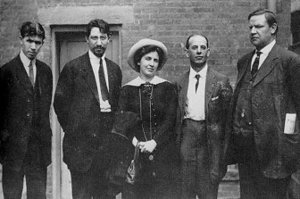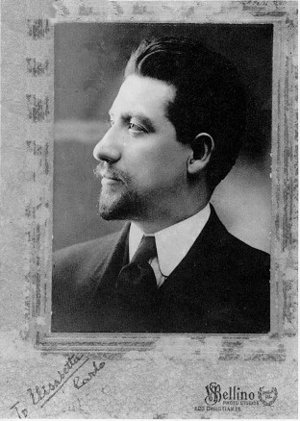Still working to recover. Please don't edit quite yet.
Carlo Tresca
Carlo Tresca (1879 - january 11, 1943 New York City) was an Italian-born American anarchist, newspaper editor, and labor agitator.
Contents
[hide]Labor organizer[edit]
He was active as the branch secretary of the Italian Railroad Workers' Federation and editor of the newspaper Il Germe. Tresca moved to the United States in 1904, to escape a prison term for his radical political activities in Italy. He settled in Philadelphia, where he became the editor of Il Proletario, the official newspaper of the Italian Socialist Federation (ISF). Tresca helped shift the political orientation of the ISF to Syndicalism.
Tresca and anarchism[edit]
Tresca's political views became increasingly more radical and he soon came to identify himself as an anarchist. Tresca resigned as editor of Il Proletario and began publishing his own newspaper, La Plebe. He would later transfer La Plebe to Pittsburgh and, with it, revolutionary ideas to Italian miners and mill workers in Western Pennsylvania.
Tresca joined the Industrial Workers of the World (IWW) in 1912, when he was invited by the union to Lawrence, Massachusetts to help mobilize the Italian workers during a campaign to free strike leaders Joseph Ettor and Arturo Giovannitti, who were in prison on false murder charges. After the victorious strike in Lawrence, Tresca was active in several strikes across the United States; the Little Falls, New York textile workers' strike (1912), the New York City hotel workers' strike (1913), the Paterson silk strike (1913), and the Mesabi Range, Minnesota, miners' strike (1916).
Opposition to fascism, Stalinism, and the Mafia[edit]

During the 1930s, Tresca became an outspoken opponent of Soviet Communists and Stalinism, particularly after the Soviet Union had engineered the destruction of the anarchist movement in Catalonia and Aragon during the Spanish Revolution. Prior to this, Tresca had supported the Bolsheviks, reasoning that a Communist state was preferable to a capitalist state, regarding Soviet Communists as allies in the fight against Fascism.
In early 1938 Tresca publicly accused the Soviets of kidnapping Juliet Poyntz to prevent her defection from the Communist Party USA underground apparatus. Tresca alleged that, before she had disappeared, Poyntz had talked to him about her disgust over Joseph Stalin's Great Terror. In 1941 Tresca, in a revealing moment, admitted to Max Eastman that Nicola Sacco was guilty of the crime with which he was charged, though Vanzetti was innocent.
In New York, Tresca also began a public campaign of criticism of the Mafia in his weekly newspaper, Il Martello. Tresca appeared to be well aware of the risk he was running to his life. At the end of an article published shortly before his death, Tresca stated, "Morris Ernst, my attorney, knows all the facts. He knows that if an anti-fascist is assaulted or killed, the instigator is Generose Pope" (this is believed to be a reference to Generoso Pope Sr., a New York political power broker with ties to mobster Frank Costello, whose Italian-American newspaper interests included the Corriere d'America and the daily Il Progresso Italo-Americano).
Assassination[edit]
By 1943 Tresca, on parole at the time, was under police surveillance. On January 9, 1943, his surveillance team witnessed an incident in which a speeding car attempted to run Tresca over.
Two days later, Tresca was leaving his parole officer's offices when he dodged surveilling officers by jumping into a car that was waiting for him. Two hours later, Tresca was crossing Fifth Avenue on foot when a black Ford pulled up beside him. A short, squat gunman in a brown coat jumped out and shot Tresca in the back and head with a handgun, killing him instantly. The black Ford was later found abandoned nearby with all four doors open. It was widely believed at the time that Mafia enforcer Carmine Galante was the suspected assassin, acting on orders from Vito Genovese, who was at the time intent on gaining Mussolini's favor by eliminating a long-time enemy.
Others have theorized that Tresca was eliminated by the NKVD as retribution for criticism of the Stalin regime of the Soviet Union.
See also[edit]
External links[edit]
| This article contains content from Wikipedia. Current versions of the GNU FDL article Carlo Tresca on WP may contain information useful to the improvement of this article | WP |
